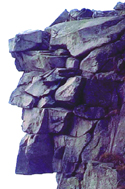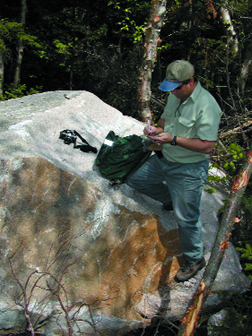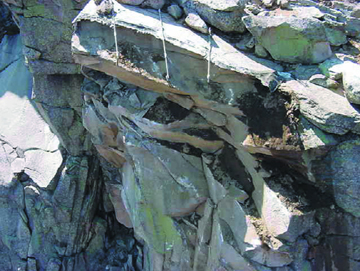Geotimes

Feature
Revisiting the
Fall of the Old Man of the Mountain
David R. Wunsch and Brian Fowler
 Just over a year ago, New Hampshire’s
famous Old Man of the Mountain collapsed from his perch on Profile Mountain
in Franconia Notch State Park. The stone structure was one of the largest naturally
occurring human profiles in the world and was the beloved emblem of the state
of New Hampshire. The Old Man’s profile showed a man’s face with a
stern but warm expression, which New Hampshire residents proudly said emphasized
their resolute, independent and pioneering spirit. Since the New Hampshire Legislature
made the Old Man the official emblem of the state in 1945, he has graced official
stationary, the state quarter and every tourist trinket imaginable.
Just over a year ago, New Hampshire’s
famous Old Man of the Mountain collapsed from his perch on Profile Mountain
in Franconia Notch State Park. The stone structure was one of the largest naturally
occurring human profiles in the world and was the beloved emblem of the state
of New Hampshire. The Old Man’s profile showed a man’s face with a
stern but warm expression, which New Hampshire residents proudly said emphasized
their resolute, independent and pioneering spirit. Since the New Hampshire Legislature
made the Old Man the official emblem of the state in 1945, he has graced official
stationary, the state quarter and every tourist trinket imaginable.
This 2001 telescopic view of New Hampshire’s Old Man of the Mountain shows
the natural profile created by overhanging blocks of granite. On May 3, 2003,
residents discovered that the profile had fallen, and since then geologists
and the state have been discussing possible ways to rebuild or memorialize the
historic site. Copyright AP/Jim Cole; courtesy of Brian Fowler.
The Old Man’s profile was visible when an observer’s line of sight
incorporated several overhanging blocks of granite, balanced on the mountain
cliff by the cantilevering of the lowest “chin” block by the successively
more massive blocks above. Measuring about 45 feet high and 26 feet wide and
weighing approximately 7,200 tons, the intricate profile resulted from chemical
weathering and freeze-thaw rock falls from the glacially eroded face of Profile
Mountain. These same processes were also responsible for its ultimate demise.
Beginnings
The absolute age of the Old Man is unknown, but it probably formed between the
retreat of the last continental ice sheet (approximately 12,000 years before
present) and its discovery in the early 19th century by early settlers of the
region. The ice sheet carved the cliffs of Profile Mountain, over which the
Old Man came to preside, by eroding deep into the Pemigewasset Valley. Once
the ice sheet melted, gravity, ice-wedging and water began eroding the cliffs
to form an apron of rock-debris slopes. The nested blocks of granite from which
the Old Man emerged were left protruding from the crest of cliffs.
The Old Man’s remarkable formation relied on selective freeze-thaw breakage
along the intersections of a series of subhorizontal and subvertical joint sets
formed in the granite body. Subsequent frost-wedging and splitting of blocks
occurred as water in the joints froze, driving the blocks apart — sometimes
resulting in the mass wasting of granite blocks off of the cliff face. The selective
breakage between the joints created the triangular shape and delicate cantilevering
of the chin and upper lip blocks, which were critical to the profile’s
stability.
Surveyors first recorded a description of the Old Man in 1805. The most famous
literary acknowledgement and tribute to the Old Man was Nathaniel Hawthorne’s
short story “The Great Stone Face,” published around 1840, endearing
the Old Man to the hearts and souls of New Hampshire’s residents.
In the 1850s, a grand hotel (the Profile House) was built in Franconia Notch.
Its guests visited the notch, seeking inspiration from the profile and its surroundings.
In 1872, the Appalachian Mountain Club and a Boston-based newspaper published
an article on the Old Man that first documented its delicate stability. At the
turn of the century, residents of Franconia began a concerted effort to stabilize
the Old Man. And in 1916, residents installed by hand approximately a dozen
steel tie rods and turnbuckles to secure blocks on the Old Man’s forehead,
in order to maintain the overall center of gravity, as it was understood at
that time.
In 1954, nine years after the New Hampshire legislature made the Old Man of
the Mountain the official emblem of the state, State Geologist Ralph Meyers
and other officials reported to the legislature that the profile was quite unstable,
despite the previous good efforts to secure its forehead portion. Moreover,
they pointed out there was a critical lack of understanding regarding the structural
mechanisms that controlled the tenuous stability of the lower blocks.
Driven by proposed highway construction through Franconia Notch, various informal
studies were undertaken, beginning in the late 1950s. However, it was not until
1976 that the New Hampshire Department of Transportation completed the first
mechanical and structural analysis of the support mechanism and stability of
the entire rock structure. That work recommended constructing the I-93 Parkway
in the notch below if blasting and other construction vibrations were kept below
ambient levels or natural vibration.
Following these recommendations, the highway was successfully completed in 1986,
without damage to the Old Man. Over the past several decades, volunteers and
crews from the state’s Department of Transportation continued a yearly
maintenance schedule by giving the Old Man a “makeover” of epoxy resins
and cement to seal cracks and fractures on its upper surfaces. They hoped to
minimize the infiltration of water, which was always presumed to be the Achilles’
heel of the Old Man.
Beginning of the end
 The Old Man
consisted of Jurassic Conway granite, which is a coarse-grained, pink biotite-granite.
The pink, or “red phase,” of the granite has been quarried for approximately
100 years in New Hampshire for building and dimension stone. In 1977, State
Geologist Glenn Stewart supervised a detailed study of the Conway granite to
evaluate its geothermal potential. As a result, a 3,000-foot borehole was drilled
into the granite to retrieve a core sample for comprehensive mineralogical and
physical study. The report from this study ultimately became a valuable source
of information related to the geology and mineralogy of the granite that made
up the Old Man, and provided insights into its weathering characteristics and
subsequent demise in 2003.
The Old Man
consisted of Jurassic Conway granite, which is a coarse-grained, pink biotite-granite.
The pink, or “red phase,” of the granite has been quarried for approximately
100 years in New Hampshire for building and dimension stone. In 1977, State
Geologist Glenn Stewart supervised a detailed study of the Conway granite to
evaluate its geothermal potential. As a result, a 3,000-foot borehole was drilled
into the granite to retrieve a core sample for comprehensive mineralogical and
physical study. The report from this study ultimately became a valuable source
of information related to the geology and mineralogy of the granite that made
up the Old Man, and provided insights into its weathering characteristics and
subsequent demise in 2003.
State Geologist David R. Wunsch collects
samples of remnants of the Old Man of the Mountain for analysis. Courtesy of
David Wunsch.
Detailed mineralogical analysis shows zones of intense weathering and alteration
of minerals in the granite, such as perthite. Approximately 40 to 90 percent
of the perthite in localized, highly weathered zones was chemically altered
to kaolinite. Zones of intense alteration occur throughout the granite, penetrating
hundreds of feet down into the rock mass. Thus, alteration along fractures most
likely penetrated deeply into the granite cliff that supported the Old Man.
Petrologic analysis of samples from the fallen forehead block identified after
the Old Man’s collapse clearly showed weathering rinds along fracture planes,
versus the fairly unweathered, competent core of the boulder. The fracture rinds
show the chemical alteration of plagioclase minerals into phyllosilicates (for
example, sericite) and the existence of numerous micro-fractures containing
iron stains, most likely from the decomposition of biotite, one of the main
constituent minerals in the granite. While efforts were made to seal fractures
from major inflows of precipitation, there was no way to prevent the microscopic
migration of water that reacts with the mineral grains between the conjoined
blocks of granite.
A close aerial examination of the rock-fall scar after the Old Man’s collapse
revealed that significant grus (weathered granite) had formed in the fracture
planes exposed on the surface, and that soil had infilled voids where fractures
were enlarged. Moreover, researchers observed green moss on the rock face that
would have been the back wall of the “cavern” — a large void
that had formed behind the chin block — indicating that sufficient wind-driven
moisture was getting behind the blocks to support vegetation. Investigators
also saw water seeping from the fractures along the rock wall behind where the
former profile blocks rested. This evidence indicated that even the best efforts
to seal off the fractured granite were insufficient in the harsh climate of
the White Mountains, where frost wedging had been subtly forcing the blocks
apart.
Revitalization
 On the morning
of May 3, 2003, New Hampshire residents, as well as the rest of the world, woke
up to the shocking news that the Old Man had fallen; it was a day of mourning.
Looking for an appropriate official response, state officials soon realized
that there were few precedents for what a state can do when it loses one of
its most significant geological features. And in the case of New Hampshire,
the incident was especially significant because the citizens had an almost sublime,
personal relationship with their state symbol.
On the morning
of May 3, 2003, New Hampshire residents, as well as the rest of the world, woke
up to the shocking news that the Old Man had fallen; it was a day of mourning.
Looking for an appropriate official response, state officials soon realized
that there were few precedents for what a state can do when it loses one of
its most significant geological features. And in the case of New Hampshire,
the incident was especially significant because the citizens had an almost sublime,
personal relationship with their state symbol.
In this aerial view of the Old Man after its collapse in May 2003, weathered
granite is visible along the joint and fracture planes that existed between
the fallen blocks. Moss (green area) grows on the cliff face, where the cavern
existed behind the chin block. Also, a wet area on the cliff face (lower left)
indicates that water was making its way down through the fractured rock. Three
turnbuckles (top center) remained after the fall. Photo by George Bliss.
Immediately after the collapse of the Old Man, New Hampshire Gov. Craig Benson
assembled the Old Man Restoration Task Force, which comprised leaders of the
New Hampshire House and Senate, civic leaders and state officials, including
the state geologist, who is first author on this story. Chaired by former New
Hampshire Gov. Stephen Merrill, the task force was charged with looking at all
options, including “rebuilding” some facsimile of the Old Man, creating
a museum and using technology to provide visitors some visual representation
of the profile at the former viewing site, which had attracted tourists from
around the world.
The state geologist provided technical support to the task force, compiling
information and producing reports that characterized the difficulties in rebuilding
or carving a replica of the Old Man in the granite cliff. Using Mount Rushmore
as an analog, the state geologist showed that the difficult logistics for construction,
compounded with the immense removal of rock necessary to reach competent granite
for sculpting and the associated environmental costs to one of the most scenic
valleys in New Hampshire, would be quite impractical. And in one of those rare
cases where public opinion coincided with scientific reality, the option of
rebuilding the Old Man or placing a prosthetic structure at the Old Man’s
former site was rejected by New Hampshire residents by an order of five to one.
In the end, it is clear that the same geological processes that created the
Old Man ultimately led to his demise. The White Mountains are in the destructive
phase of their life cycle. Tenacious chemical weathering, frost-wedging, mechanical
stress and gravity all have conspired to send the Old Man down to the talus
pile below.
It’s a true example of “geology in action.” Rust never sleeps.
Wunsch is the state geologist
of New Hampshire and director of the New Hampshire Geological Survey. He served
as a member of the governor’s Old Man Restoration Task Force. Fowler is the
consulting engineering geologist who conducted both the 1976 and post-collapse
analyses of the Old Man’s rock mechanics.
The authors would like to acknowledge Wallace “Wally” Bothner and Jeffrey
E. Schulz in the Department of Earth Sciences at the University of New Hampshire
for their assistance and petrographic analyses of the Conway granite.
Back to top
 Just over a year ago, New Hampshire’s
famous Old Man of the Mountain collapsed from his perch on Profile Mountain
in Franconia Notch State Park. The stone structure was one of the largest naturally
occurring human profiles in the world and was the beloved emblem of the state
of New Hampshire. The Old Man’s profile showed a man’s face with a
stern but warm expression, which New Hampshire residents proudly said emphasized
their resolute, independent and pioneering spirit. Since the New Hampshire Legislature
made the Old Man the official emblem of the state in 1945, he has graced official
stationary, the state quarter and every tourist trinket imaginable.
Just over a year ago, New Hampshire’s
famous Old Man of the Mountain collapsed from his perch on Profile Mountain
in Franconia Notch State Park. The stone structure was one of the largest naturally
occurring human profiles in the world and was the beloved emblem of the state
of New Hampshire. The Old Man’s profile showed a man’s face with a
stern but warm expression, which New Hampshire residents proudly said emphasized
their resolute, independent and pioneering spirit. Since the New Hampshire Legislature
made the Old Man the official emblem of the state in 1945, he has graced official
stationary, the state quarter and every tourist trinket imaginable.
 The Old Man
consisted of Jurassic Conway granite, which is a coarse-grained, pink biotite-granite.
The pink, or “red phase,” of the granite has been quarried for approximately
100 years in New Hampshire for building and dimension stone. In 1977, State
Geologist Glenn Stewart supervised a detailed study of the Conway granite to
evaluate its geothermal potential. As a result, a 3,000-foot borehole was drilled
into the granite to retrieve a core sample for comprehensive mineralogical and
physical study. The report from this study ultimately became a valuable source
of information related to the geology and mineralogy of the granite that made
up the Old Man, and provided insights into its weathering characteristics and
subsequent demise in 2003.
The Old Man
consisted of Jurassic Conway granite, which is a coarse-grained, pink biotite-granite.
The pink, or “red phase,” of the granite has been quarried for approximately
100 years in New Hampshire for building and dimension stone. In 1977, State
Geologist Glenn Stewart supervised a detailed study of the Conway granite to
evaluate its geothermal potential. As a result, a 3,000-foot borehole was drilled
into the granite to retrieve a core sample for comprehensive mineralogical and
physical study. The report from this study ultimately became a valuable source
of information related to the geology and mineralogy of the granite that made
up the Old Man, and provided insights into its weathering characteristics and
subsequent demise in 2003. On the morning
of May 3, 2003, New Hampshire residents, as well as the rest of the world, woke
up to the shocking news that the Old Man had fallen; it was a day of mourning.
Looking for an appropriate official response, state officials soon realized
that there were few precedents for what a state can do when it loses one of
its most significant geological features. And in the case of New Hampshire,
the incident was especially significant because the citizens had an almost sublime,
personal relationship with their state symbol.
On the morning
of May 3, 2003, New Hampshire residents, as well as the rest of the world, woke
up to the shocking news that the Old Man had fallen; it was a day of mourning.
Looking for an appropriate official response, state officials soon realized
that there were few precedents for what a state can do when it loses one of
its most significant geological features. And in the case of New Hampshire,
the incident was especially significant because the citizens had an almost sublime,
personal relationship with their state symbol. 